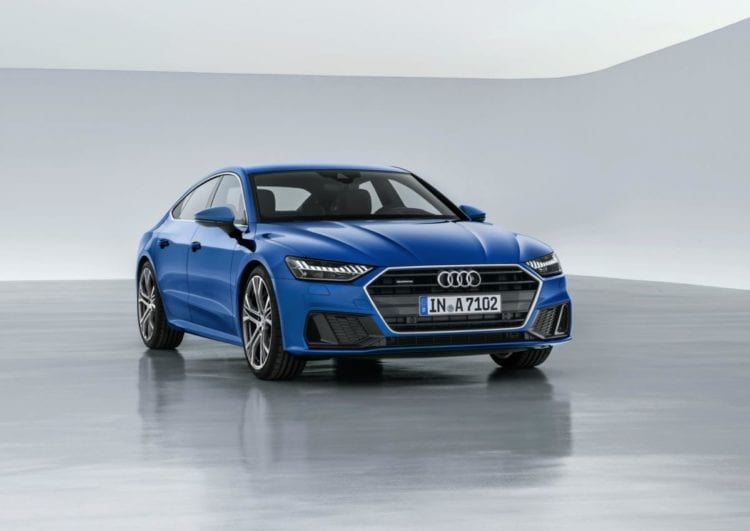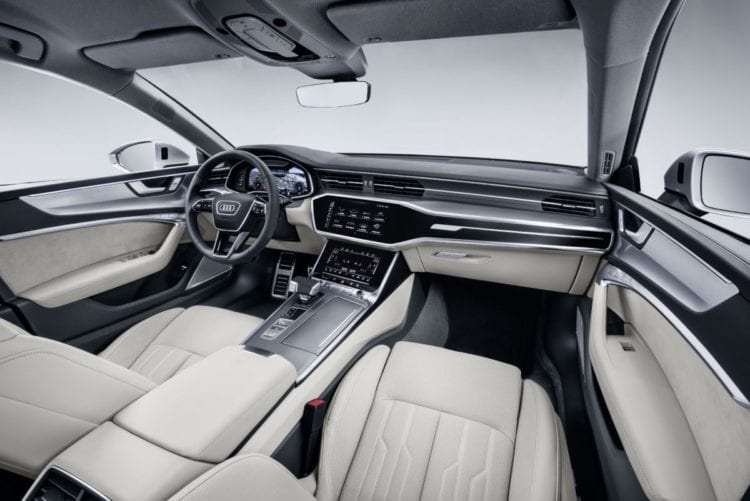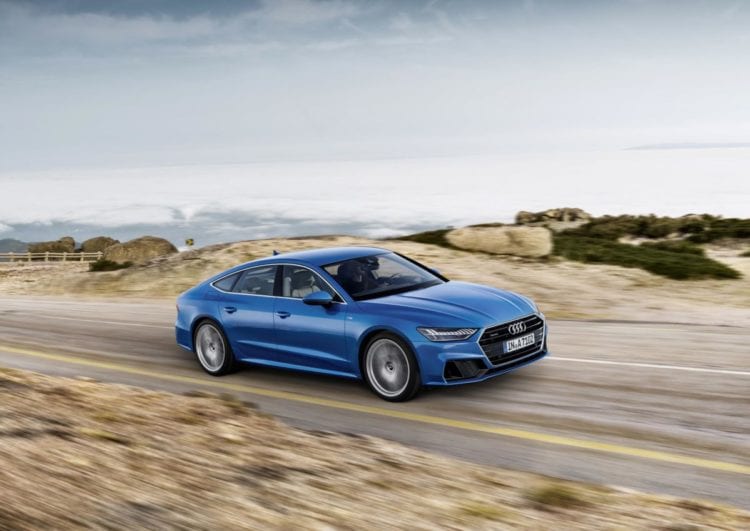Audi has a completely new slant on the concept of the five-door coupé for the executive class – the first A7 Sportback in which the brand successfully combined the svelte lines of a classic grand tourer with the reality-ready attributes of Saloon and Avant models is about to give way to its successor. Fluent in the new Audi design language, conversant with the brand’s latest technological advances and comfortable with articulating its most recent drivetrain developments, the 2018 A7 evolves and finesses every facet of the Sportback theme without losing sight of the hallmarks behind its original appeal.
Dynamics at their most beautiful: the exterior design

The exterior design of the A7 Sportback is an expression of the new design language that Audi introduced with the prologue study and that made its production debut in the new Audi A8. With large surfaces, sharp edges and taut, athletic lines, the A7 conveys dynamism and progressiveness from every perspective.
Up front, the Singleframe grille – wider and lower than that of the Audi A8 – the narrow headlights, the boldly contoured air inlets and the flat front end signal intent. In some versions the light signature takes up the subject of digitalisation: 12 adjacent lighting segments separated by narrow intervening spaces evoke associations with the binary digits 0 and 1. The top lighting configuration is the HD Matrix LED headlight with Audi laser light.
With its long bonnet, long wheelbase and short overhangs the A7 Sportback looks lean and muscular yet also innately elegant. Its key dimensions give more than a clue to its character: It is 4,969 millimetres long, has a wheelbase of 2,926 millimetres and is 1,908 millimetres wide, but stands only 1,422 millimetres high. Pronounced contours emphasise the wheels, which measure up to 21 inches in diameter, and reference Audi’s quattro genes. These genes determine the proportions of the vehicle’s body. The silhouette is defined by the dynamic roofline, which drops sharply towards the rear.
As with the previous model, the tapered rear with its long luggage compartment lid terminates in a pronounced, curved lip from which an integrated spoiler extends automatically at 74mph and above. A flat light strip – a design feature common to all of Audi’s top models – joins the rear lights, whose tail lights are made up of 13 vertical segments. When the doors are unlocked and again when they are locked, fast-moving light animations play in the rear lights and in the headlights, highlighting the imposing coupé’s dynamics while standing still. The progressive exterior design of the new Audi A7 Sportback is largely devoid of embellishment, and is presented in a choice of 15 colours, eight of which are new. S line models further hone the look through modifications to the radiator grille and the front air inlets, the sills and the front and rear diffusers. They are trimmed in gloss black and more strongly sculpted.
Show car design comes to production: the interior

The cabin fuses design and technology in a unique way. The interior of the new Audi A7 Sportback has been conceived according to a reduced, clean design language, with an emphasis on horizontal lines and a sleek instrument panel creating a feeling of airy spaciousness. The centre console is oriented toward the driver, underscoring the Grand Tourer’s stated aim of combining progressive design, intuitive functionality and sophistication with inherent driver appeal. All colours, upholstery materials and inlays reflect the new aesthetic.
The 10.1-inch upper display (in combination with MMI navigation plus) is tilted towards the driver, and with its black panel optics and graphite grey aluminium clasp, almost disappears into the dashboard when switched off. The body supporting the clasp is itself a geometric sculpture. The display’s user interface appears as soon as the car is opened. In keeping with the interior design, the look is reduced and succinct. All screen content can be quickly registered.
At your fingertips: MMI touch response control system and online voice control

The new Audi A7 systematically continues the digitalisation strategy of the A8. The interior architecture melds seamlessly with Audi’s new MMI touch response operating concept. It replaces the rotary pushbutton and the conventional buttons and controls of the previous model with two large, high-resolution touch displays.
The driver controls the infotainment system from the upper display. Mounted on the asymmetric console of the centre tunnel, the 8.6-inch lower display provides access to the climate control system, comfort functions and text input. Drivers can rest their wrist on the automatic transmission’s wide selector lever knob.
Audi offers an optional head-up display that projects important information onto the windscreen. MMI navigation plus – the highest level infotainment system – also includes the fully digital Audi virtual cockpit with its rendered dials and 12.3-inch display.
The MMI touch response operating concept features haptic and acoustic feedback and is as intuitive to use as a smartphone. Users hear and feel a click as confirmation when their finger triggers a function. With its logical and flat menu structure, the system allows fast access to the various vehicle functions, and it can also be personalised thanks to configurable and movable favourites buttons.
The optional voice control in the new A7 Sportback makes operation even more convenient. With MMI navigation plus, the natural speech dialogue system processes questions and commands in two ways – with information stored onboard and at the same time with detailed knowledge from the cloud.
Fully connected for more convenience and safety
With its comprehensive connectivity, the Audi A7 is perfectly equipped for long-distance touring. It offers customers the same broad range of convenience, safety and customisation technologies as the new Audi A8. Up to seven drivers can store their preferred settings in individual user profiles, and as many as 400 parameters can be personalised. The online services from Audi connect have been expanded to include features such as the traffic sign and hazard information Car-to-X services, which utilise the swarm intelligence of the Audi fleet.
The top MMI navigation plus package will be available with a choice of two sound system upgrades, the most sophisticated being Bang & Olufsen Advanced Sound System capable of delivering advanced 3D sound.
Intelligent and convenient: the Audi AI systems
With the AI button, the driver will be able to activate the Audi AI remote parking pilot and the Audi AI remote garage pilot, which will be made available during 2018. They autonomously manoeuvre the A7 Sportback into and out of a parking space or garage. The driver can get out of the car before launching the function via the myAudi app on their smartphone. To monitor the manoeuvre, the driver presses and holds the Audi AI button throughout. The central driver assistance controller (zFAS) merges the data from a sophisticated set of sensors to continually compute an image of the surroundings. Depending on the equipment level, there can be as many as five radar sensors, five cameras, 12 ultrasonic sensors and a laser scanner.
In addition to the Audi AI systems, the new A7 Sportback features a total of 39 driver assistance systems to make daily use easier for the driver. They are split into three packages: the Audi AI parking package (gradual introduction beginning in 2018), the City assist package with the new crossing assist, and the Tour assist package. The latter includes such things as the efficiency assistant, which facilitates a driving style conducive to reducing consumption, and the adaptive driving assistant (ADA), which supplements the adaptive cruise control (ACC) with helpful steering interventions designed to keep the car in its marked lane. All driver assistance systems feature improved control mechanisms.
Handling and long-distance comfort: the chassis
The role of the Grand Tourer as a haven of comfort during effortless trans-continental journeys is also facilitated by the platform underpinning the new A7 Sportback. The new electronic chassis program (ECP) – the central controller for the chassis – and the updated air suspension make it even more comfortable yet also appreciably more nimble and agile. Its ability on challenging roads can be amplified further by the addition of optional dynamic all-wheel-steering, which not only benefits low-speed manoeuvrability but also composure at higher speeds, and by the optional sport differential, which actively distributes drive torque between the rear wheels.
Many aspects of the front and rear axles have been newly developed. The standard progressive steering, whose ratio becomes progressively more direct the further the steering wheel is turned, features a new concept for intensive road feedback. Mounted behind large wheels – up to 21 inches and 255/35 – with improved rolling comfort are aluminium fixed-caliper brakes with discs up to 400 millimetres (15.7 in) in diameter. Customers can choose between four suspension set-ups: a conventional steel spring suspension, the sport suspension that lowers ride height by 10 millimetres, electronically controlled damping and the self-levelling adaptive air suspension.
The top chassis-related innovation is dynamic-all-wheel steering. It combines remarkably direct steering response with unshakable stability, resolving the conflict of aims between agility and comfort. The steering ratio varies as a function of speed between 9.5:1 and 16.5:1 by means of active steering interventions at the front and rear axle. At the front axle, strain wave gearing is used to superimpose these in response to the driver’s steering input. At the rear axle, a spindle drive turns the wheels by as much as five degrees. At low speed, they steer counter to the front wheels to further increase the agility of the big coupe when parking or driving in urban traffic, for example. This reduces the turning circle at full lock by 1.1 metres. At 37mph and above, the rear axle steers in the same direction to increase straight-line stability and facilitate lane changes.
Like the sport differential, controlled damping and the adaptive air suspension, the dynamic all-wheel-steering is integrated into the control function of the electronic chassis platform (ECP). These systems are closely networked for maximum precision. The driver can use the Audi drive select system to activate different ride profiles in which the differentiation between comfort and dynamic options is more pronounced than in the previous model.
Broad-based electrification: mild hybrid system for greater comfort and efficiency
All A7 Sportback models will be equipped with a new mild hybrid system (MHEV) for greater comfort and efficiency. With the V6 engines, this uses a 48-volt primary electrical system. A belt alternator starter (BAS) works together with a lithium-ion battery and achieves a recuperation performance of up to 12 kW when braking. At speeds of between 34 and 99mph, the large coupé can coast in freewheeling mode with the engine deactivated and then restart comfortably via the BAS.
The start-stop function has been significantly expanded and now activates at 13mph. In combination with the standard front camera, the engine is restarted predictively while at a standstill as soon as the vehicle ahead begins to move. In real-world driving, the MHEV technology reduces fuel consumption by up to 0.7 litres per 100 kilometres.
The new Audi A7 Sportback will initially launch with the 3.0 V6 TFSI petrol engine. The super-refined V6 turbo produces 340PS and 500 Nm (368.8lb-ft), propelling the elegant five-door coupé from 0 to 62mph in 5.3 seconds and on to a top speed of 155mph. In the NEDC, the entry version of the Audi A7 55 TFSI returns up to 41.5mpg, corresponding to CO2 emissions of 154 grams. The 3.0 TFSI is paired with a seven-speed S tronic twin-clutch transmission, and its output is proficiently managed by the latest iteration of the quattro drivetrain using the efficient ultra technology that activates rear-wheel drive as needed. Additional six- and four-cylinder engines, both petrol and diesel, will follow shortly after the start of production.
The body concept: Coupé, Saloon and Avant in one
The A7 Sportback combines the best of all worlds for business and recreational use. It offers the design of a Coupé, the space of a Saloon and the versatility of an Avant. The interior concept of the A7 Sportback impresses with more space and more comfortable seating – and that despite having a dynamic roofline. Compared with the previous model, interior length has increased by 21 millimetres, resulting in more rear knee room. Rear passengers also enjoy more head room. The loading width has also increased compared with the previous model and now measures 1,050 millimetres.
Topping the range of all-new seats are the multi-adjustable, customised contour front seats with ventilation and massage. The three-seat rear bench (standard in the UK) offers plenty of space and comfort. New high-tech options make life with the Audi A7 Sportback even more comfortable and convenient. The air quality package improves interior air quality by means of fragrancing with subtle scents, an ioniser and an effective combination filter.
The body, which features steel and aluminium composite construction with large components such as add-on parts made of aluminium, is a key factor in the improved handling and greater comfort. The four-door coupe scores top marks with respect to body stiffness, aeroacoustics and aerodynamics. Passengers benefit from improved acoustic comfort and – thanks to sophisticated aerodynamics – minimal wind noise.
The improved panoramic glass sunroof with particularly large glass elements lets more light into the cabin. The heated windscreen and wipers with integrated nozzles are additional options for more convenience.
Despite the rakish lines of the body, the luggage compartment has a base capacity of 535 litres. This increases to 1,390 litres with the rear seats folded down. The luggage compartment has been optimised so that two golf bags now fit horizontally – in addition to the optional spare tyre. The optional sensor-controlled rear hatch opens and closes automatically in response to a foot motion.
Produced at the Neckarsulm site in Germany, the new Audi A7 Sportback will be available to order in the UK from early 2018, with pricing for the first phase of models starting from approximately £56,000 OTR.
